
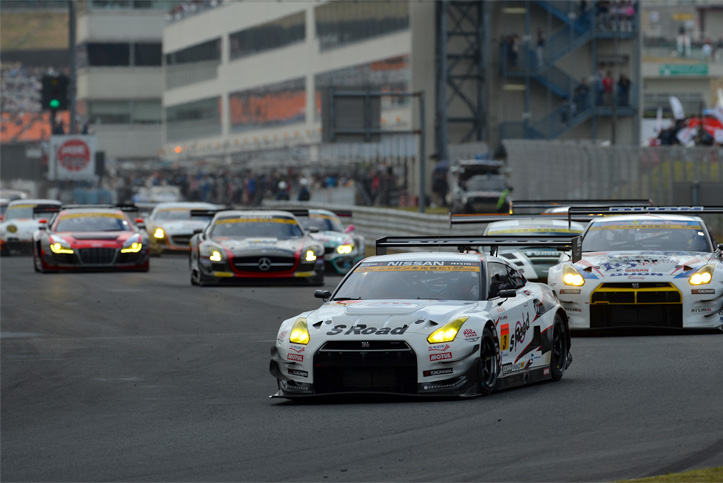
OFF SEASON SPECIAL -4-
Japanese and German FIA GT3 race cars became a dominant force in the GT300 class.
At last, 2014 is here, but it makes us more longing to see the season to begin. The exercise to look back last season’s SUPER GT race cars before the new season starts is seeing the fourth edition. From this edition, we will shed lights on the GT300 class. Firstly, we will bring you the FIA GT3 specification cars supplied by automakers from Germany and Japan.
Before we start, let’s look back the overview of GT300 class. Last year, the GT300 class had cars built in compliance with two different technical regulations, and one of them was the “FIA GT3” regulation. It is the GT car regulation defined by FIA (Federation Internationale de l'Automobile). FIA GT3 cars are created exclusively for racing by respective automaker or its alliance tuner and sold in the market. It is not something you can normally buy giving the limited number of production and the price of around 40 million yen, but still it’s considered cheaper compared to those one-of-the-kind race cars, and is gaining popularity not only in SUPER GT but in GT races around the world. However, vehicles that participate in the series are not permitted to change not only the aerodynamics and engine but also even the gear ratio from the regulated specification defined for the model of respective year. It would lead to reduction of cost required to participate in the race, but the flexibility in setting up the car for different circuits would also be reduced, thus the suitability and unsuitability of a car to track layout tends to be distinct. Photos of each car from the season opener at Okayama and the final round at Motegi are posted below, however, you cannot tell the difference like you see in the GT500 class cars or JAF-GT300 cars.
Photo at the top of this page is from the start of Round 7 Autopolis with No.3 S Road NDDP GT-R, the only pole-sitting FIA GT3 car in 2013, at the lead.
○BMW Z4 GT3 [Germany]
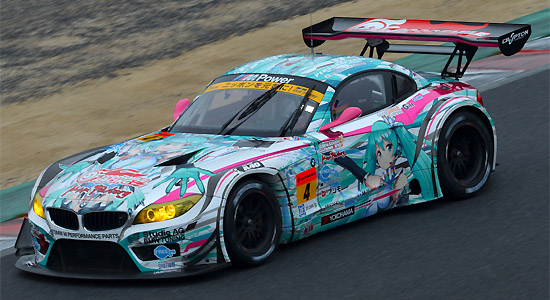
Rd.1 OKAYAMA No.4 GSR HATSUNEMIKU BMW
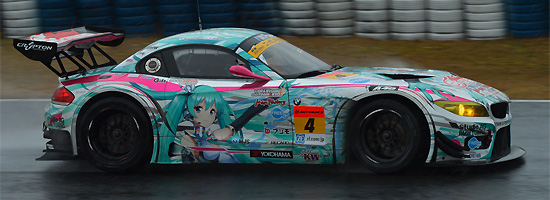
Rd.1 OKAYAMA No.4 GSR HATSUNEMIKU BMW
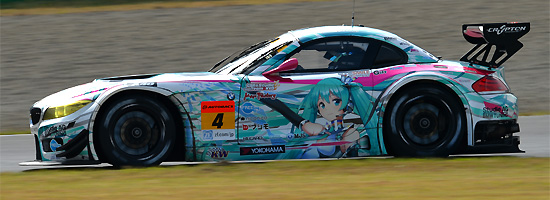
Rd.8 MOTEGI No.4 GSR HATSUNEMIKU BMW
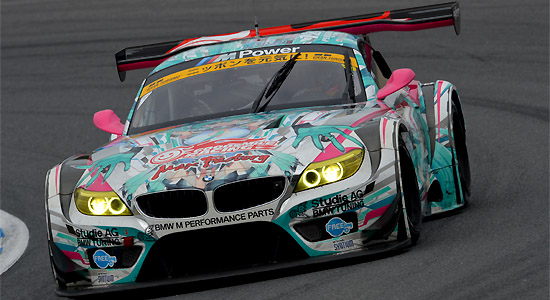
Rd.8 MOTEGI No.4 GSR HATSUNEMIKU BMW
When it won the GT300 Championship in 2011, it was advantageous in the top speed over the JAF-GT300 cars, the major force of then. However, in last two years where more FIA GT3 rivals began to compete in the series, the BMW is taking on the rivals with its cornering and braking performances and fuel efficiency. In 2013 season, it won the Round 6 Fuji and Round 7 Autopolis consecutively. Both races were held under heavy weather, but it was its total strength consisted of the stability of the car, team’s strategy, and drivers’ skill that brought them the victory.
Noticeable features in terms of aerodynamic parts were the supplementary wing under the rear wing and the unique shape of side mirror, unlike other cars. It was announced that transaxle (allocation of transmission to back part of car) would be adopted for the 2013-model, but the idea was put off after all.
○Mercedes Benz SLS AMG GT3 [Germany]
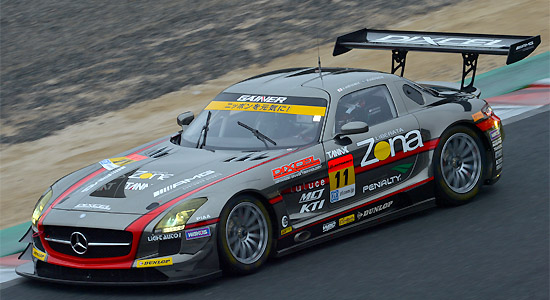
Rd.1 OKAYAMA No.11 GAINER DIXCEL SLS
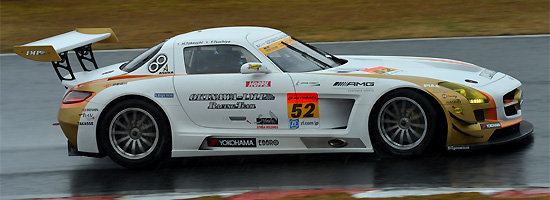
Rd.1 OKAYAMA No.52 OKINAWA-IMP SLS
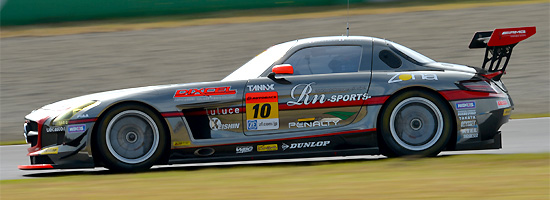
Rd.8 MOTEGI No.10 GAINER Rn-SPORTS DIXCEL SLS

Rd.8 MOTEGI No.62 LEON SLS
Side view of SLS brings a thought to the mind once again. It doesn’t matter if someone might say nostalgia, but a long-nose coupe is indeed COOL. It scored two wins and both wins were at races with no handicap weight, the season opener and final round, and this is what Mercedes-Benz all about. But, on the other hand, given rather heavier bodyweight, the performance tends to drop easily if the handicap weight accumulates.
It enjoyed an advantage of quick exiting of corners realized by the fat torque that the 6.2-liter V8 engine produced, and showed strength at technical circuits. In aerodynamics, the air outlets on the hood and back part of front fenders, enabled by the long-nose, give strong impact to the eyes, and they seemed to be effective in increasing the downforce around the front area. For the 2013-model, improvements were made to reduce the bodyweight, which was a weak point of the vehicle.
○Audi R8-LMS ultra [Germany]
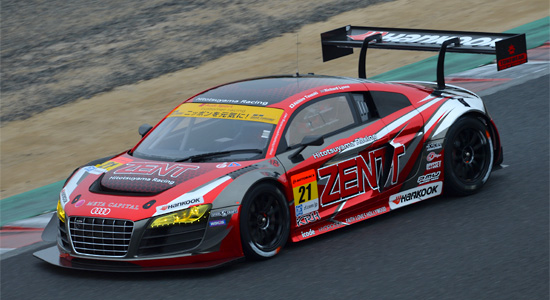
Rd.1 OKAYAMA No.21 ZENT Audi R8 LMS ultra
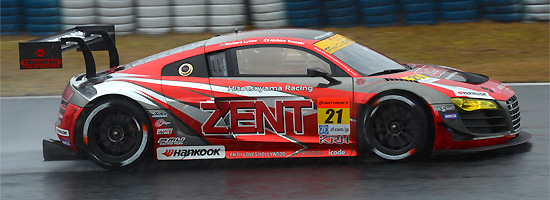
Rd.1 OKAYAMA No.21 ZENT Audi R8 LMS ultra
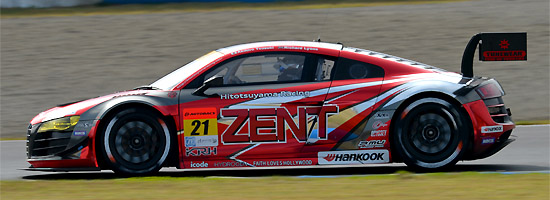
Rd.8 MOTEGI No.21 ZENT Audi R8 LMS ultra
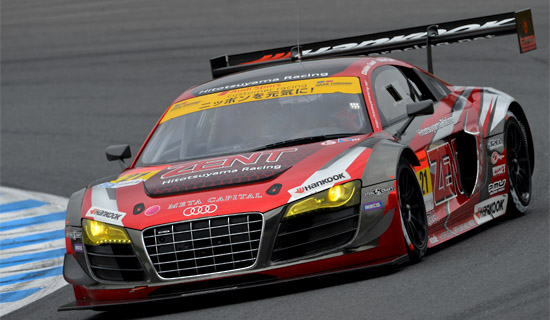
Rd.8 MOTEGI No.21 ZENT Audi R8 LMS ultra
Audi R8 marked one win and one pole position in 2012, which put it in the position to contend for the title, but it couldn’t get the result in the way it would want in 2013. Significant changes were made on the aerodynamics parts along with weight reduction on the 2013-model, and the swan-neck stay, like those installed on GT500 cars, was adopted for the rear wing. New parts were anticipated for the diffuser at the backend, but it was put off because the parts could not obtain the homologation. Side mirror was also unique with an aerodynamic design with the sharp edge pointing upward.
○PORSCHE 911 GT3 R [Germany]
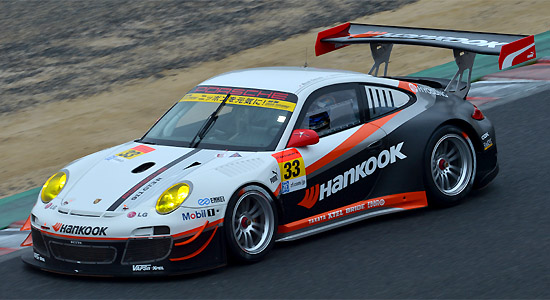
Rd.1 OKAYAMA No.33 HANKOOK PORSCHE

Rd.1 OKAYAMA No.0 ENDLESS TAISAN PORSCHE
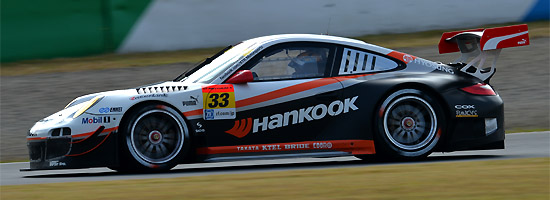
Rd.8 MOTEGI No.33 HANKOOK PORSCHE
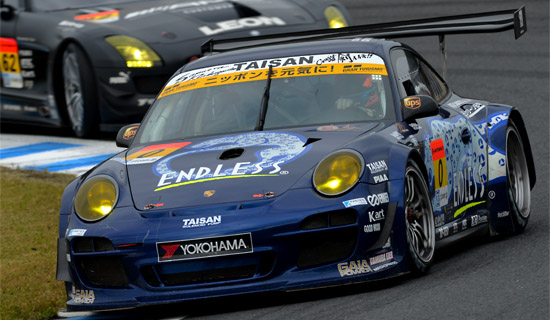
Rd.8 MOTEGI No.0 ENDLESS TAISAN PORSCHE
Porsche 911GT3R became the champion model of 2012. Significant modification was done in the aerodynamics with a vision to extend its advantage also to the cornering performance, but things did not go in the way anticipated. With the rivals catching up in the speed on the straightaway, which was one of the key factors that brought them the title, it was just a bitter year for the model. For this reason, No.0 ENDLESS TAISAN PORSCHE made a decision to bring back the 2012-model again for the last two races. You can see and compare from the photos above the difference in the front area between the 2013-model at the season opener and the 2012-model at the final round. There is an obvious difference in the shapes of nose at front.
Also, the width of front fender was extended (overall width got also wider) and slits to let the air out were created at the top of fenders. Bottom part of the rear half of the front fender was taken out like the rear fender of SC430 in the GT500 class. Contrasting to the conventional form adopted by the rivals, Porsche 911’s rear wing had a 3D design with the front edge in curvature.
○NISSAN GT-R NISMO GT3 [Japan]
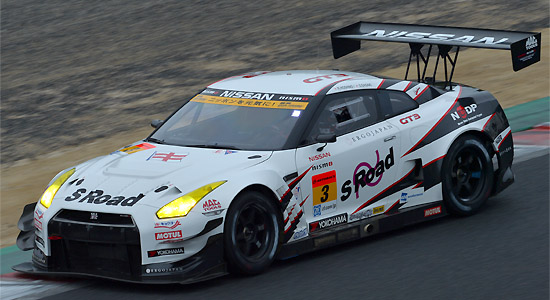
Rd.1 OKAYAMA No.3 S Road NDDP GT-R
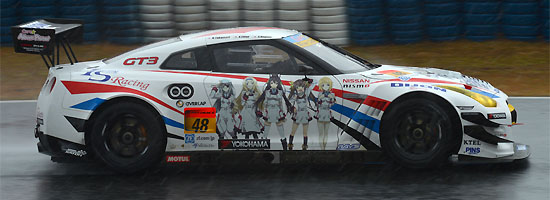
Rd.1 OKAYAMA No.48 DIJON Racing IS GT-R
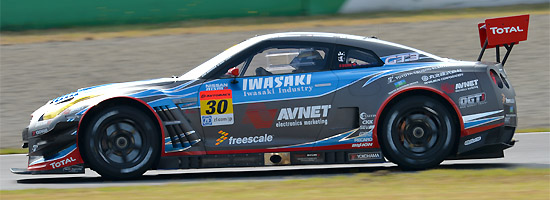
Rd.8 MOTEGI No.30 IWASAKI OGT Racing GT-R
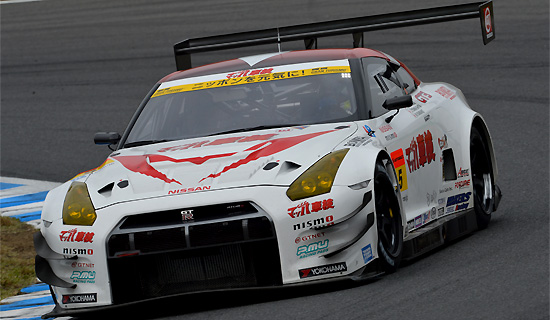
Rd.8 MOTEGI No.5 MACH GoGoGo SYAKEN GT-R
There was only one car competing in its debut year of 2012, but in 2013 NISSAN GT-R NISMO GT3 became a sufficient force with four cars at the season opener and five cars at the end. Although the model could not pull off a win until the Fuji Sprint Cup, a special event, it showed off its performance fully by being involved in the battle for the win at almost every race in the season.
Modifications were seen at almost everywhere in the 2013-model, but especially around the increase of power output (speed on the straightaway) and the improvement of understeering (increasing the downforce at the front part of car). Highlight in the aerodynamics would be the large canard at front. Double canard is a standard in the FIA GT3, but the one on GT-R is larger compared to others. And the slits at the back part of front fender, which resembles GT-R in the GT500 class, are also a unique feature of the vehicle. It seemed that the engine output was also increased by about 20 horsepower. It favored a track with many high-speed corners like Fuji, Suzuka, and SUGO given the fat torque realized by the turbo. No.360 RUN UP GROUP GT-R fielded a 2012-model.
| 4/13-14 | Round1 OKAYAMA | |
| 5/03-04 | Round2 FUJI | |
| 6/01-02 | Round3 SUZUKA | |
| 8/03-04 | Round4 FUJI | |
| 9/21-22 | Round6 SUGO | |
| 10/19-20 | Round7 AUTOPOLIS | |
| 11/02-03 | Round8 MOTEGI | |
| 12/07-08 | Round5 SUZUKA |